by Ian Skellern
Welcome to the 2016 edition of Quill & Pad’s early Grand Prix d’Horlogerie de Genève predictions in which the team picks favorites and explains why. Please enjoy the opinions of the following panelists:
Ian Skellern (IS), co-founder and technical director
Joshua Munchow (JM), resident nerd writer
GaryG (GG), resident collector
Martin Green (MG), resident gentleman
Nancy Olson (NO), resident pen expert and watch writer
Ryan Schmidt (RS), author of The Wristwatch Handbook: A Comprehensive Guide to Mechanical Wristwatches and contributor
As a jury member, editor-in-chief Elizabeth Doerr is excluded from these early predictions.
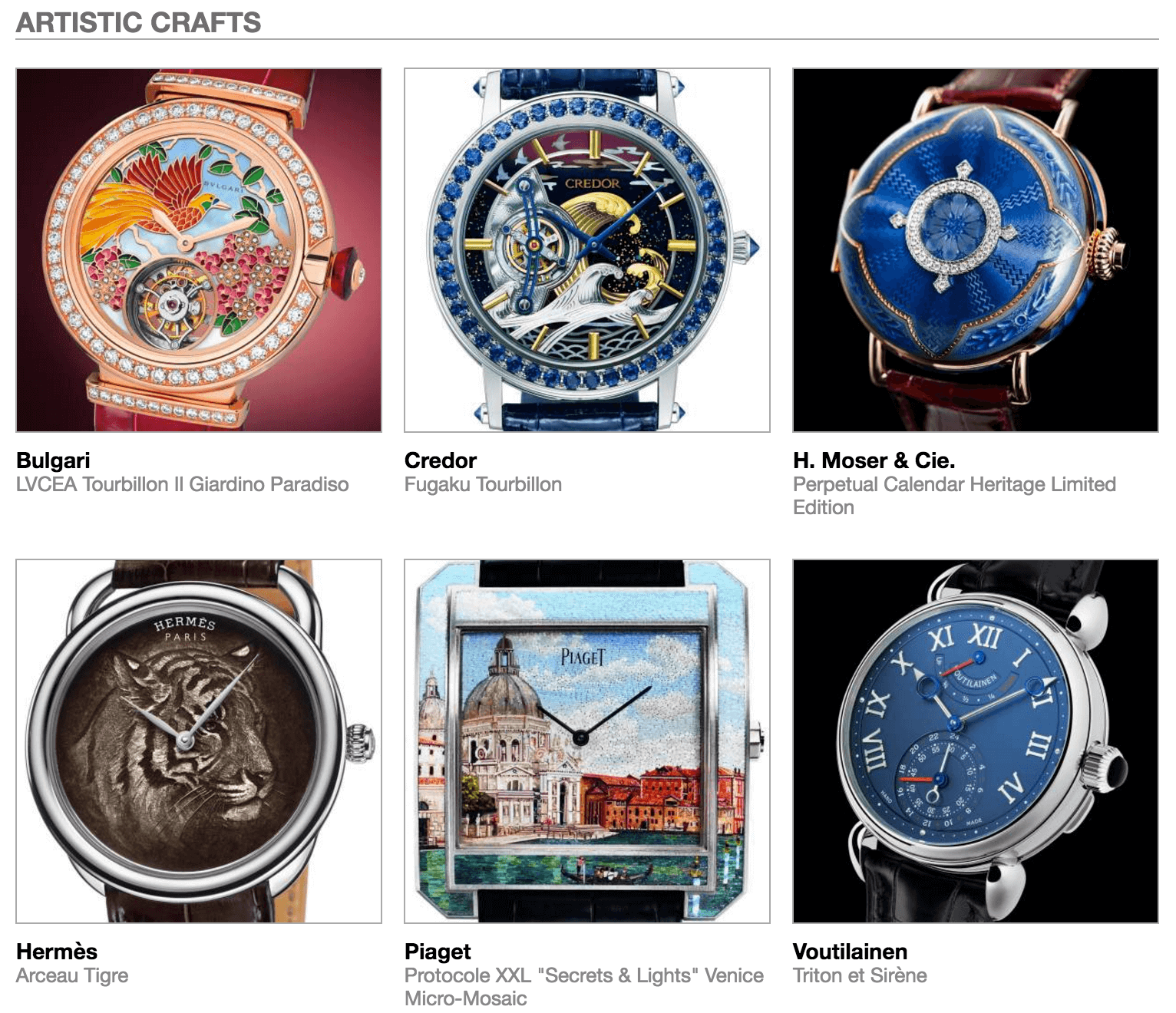
Pre-selected Artistic Craft watches in the 2016 GPHG
Artistic Crafts are defined by the GPHG as, “Watches demonstrating exceptional mastery of one or several artistic techniques such as enameling, lacquering, engraving, guilloché (engine-turning), skeleton-working, etc.”
IS: I thought that the 2016 Men’s category featured the strongest lineup I’d ever seen in the GPHG, but that’s now been matched by the pre-selected watches in this year’s Artistic Crafts category. Any of these watches could justifiably take the prize here and I suspect that it will come down to the subjective tastes of the individual jury members rather than any Spock-like logic.
RS: That’s what I thought, Ian! This an especially tough section because it is particularly subjective and well-stocked this year. So I have taken a look at the rulebook for some objective guidance.
There are a couple of watches in here that I would walk hot coals for; however, I am cautious about placing my own aesthetic preferences over and above the watches that are of greater artistic merit. So while the subject matter, the colors, and the overall aesthetic do carry weight, the overall craft is more important here.
IS: It’s also well worth bearing in mind that there is no substitution for handling these Artistic Craft watches to fully appreciate the intricate skill involved.
GG: What a selection of watches! I’m a big fan of métiers d’art, and each of the pieces selected in this category has much to offer in my view. I found it particularly notable that almost all of the pre-selected pieces featured multiple crafts, and the exception (the Piaget) “simply” featured a micro-mosaic comprising more than 5,000 tiny pieces!
That’s not to mention that one of the watches of the year for me, and perhaps the one that I would love to own most for myself, would have fallen into this category had its owner allowed it to be viewed in public. I saw it privately at Baselworld, and it absolutely blew me away
IS: If you are talking about that secret Romain Gauthier, Gary, I am with you there.
JM: The Artistic Crafts category is always a difficult category to judge since it is inherently a subjective topic. Art speaks to each person differently, and these watches are no different. This year the effort is even more strenuous due to the fact that all of the watches use abnormally difficult techniques resulting in a wide variety of styles. Only one watch can be considered standard “Artistic Craft” fare, and even that watch is incredible.
So after a lot of deliberating I’ve had to make some hard decisions.
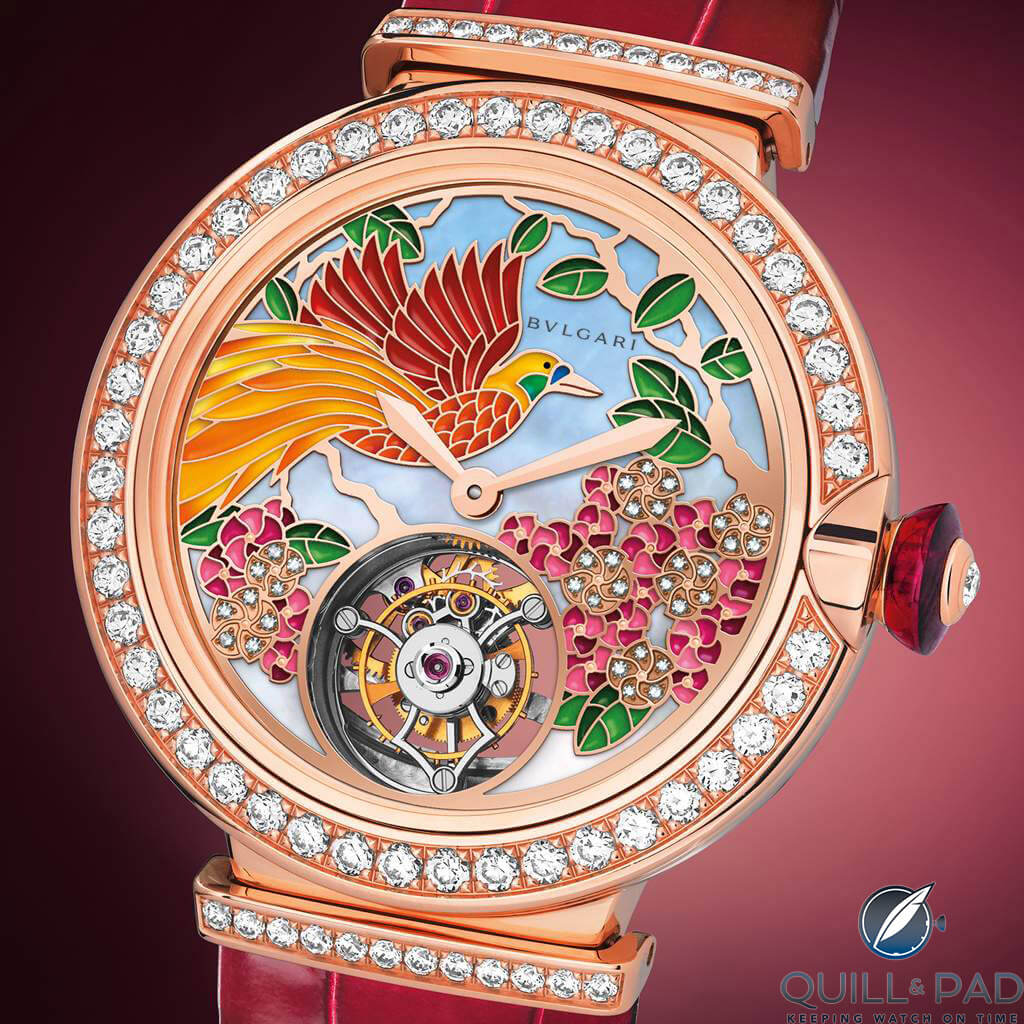
Bulgari LVCEA Tourbillon Il Giardino Paradiso
Bulgari LVCEA Tourbillon Il Giardino Paradiso
MG: Bulgari once more shows off its Italian flair with the LVCEA Tourbilon II Giardino Paradiso. Small details turn a watch that could very easily have become gaudy into an intricate masterpiece.
Pay attention to the way the lugs are placed in relation to the case. And that unique crown! It provides great balance to the painted dial, which is upgraded by the use of mother-of-pearl and diamonds.
IS: Talk about an explosion of vibrant color! The Bulgari Il Giardino Paradiso is one of the most brightly colorful wristwatches I’ve ever seen, and both the bird of paradise as a subject and the artistic methods used in its execution look sensational. Bulgari’s timepieces are often too over-the-top for my usually more sedate tastes, but the brand has hit a home run with this model.
Just look at the range of techniques and materials used: sublime blue mother-of-pearl for the sky, hand painted bird and foliage, diamond-set for added sparkle, and then the bezel, crown, and lugs all set with diamonds for maximum scintillation. The tourbillon in the bird’s perch is just the icing on the cake.
This is a spectacular timepiece.
Quick Facts Bulgari LVCEA Tourbillon Il Giardino Paradiso
Case: 38 x 11.14 mm, pink gold, set with 45 brilliant-cut diamonds (1.7 ct)
Movement: automatic Caliber BVL 263 with one-minute tourbillon and 64 hours of power reserve
Dial: mother-of-pearl, miniature painting, 34 brilliant-cut diamonds
Functions: hours, minutes
Limitation: 50 pieces
Price: 105,000 Swiss francs
Moser & Cie. Perpetual Calendar Heritage Limited Edition
IS: To seriously compete in this category it is no longer enough to demonstrate mastery of just one artistic craft unless it’s extremely rare or extremely difficult one to execute. On the Perpetual Calendar Heritage Limited Edition, Moser has incorporated an incredible five crafts . . . and that’s excluding the superb watchmaking.
No less than five artisans worked together to achieve the creation of the Perpetual Calendar Heritage: there is cloisonné enamel for the two case covers, oven-fired enamel for the dial, intricate guilloche under the enamel on the covers, engraving, and gem setting. Then there are the mechanics of the pushbutton cover – and that’s all on top of the superb Moser perpetual calendar movement inside.

H. Moser & Cie. Perpetual Calendar Heritage Limited Edition with decorated protective cover closed
RS: Moser has made the bold move of encasing the watch in between two covers, each of which offers a blank canvas for decoration on a scale exceeding the diameter of the dial. As a result, the cloisonné enamel is barely “cloisonné” and there are large areas of gorgeous, uninterrupted blue enamel.
The foundation of the cover is engine-turned so as to produce a bold flinqué effect, bringing it to life spectacularly with just one rich blue color in the enamel. That’s the punch that drops your guard; the sober grand feu dial beneath the cover is the jab that knocks you off your feet.
JM: The category was so hard that my second runner-up is a tie between two incredible watches, this and the Hermès Arceau Tigre.
The H. Moser & Cie. Perpetual Calendar Heritage Limited Edition follows a similar route of engraving viewed through enamel but creates a completely different result. A highly decorated hunter style case features guilloche, hand engraving, and stone setting that combine to make for a very elegantly classic case. The relief engravings are coated with stunning blue enamel allowing the light to play with the texture beneath the surface, increasing the depth of the case. Both watches are excellent examples of engraving mixed with enamel and choosing one over the other simply comes down to personal style.
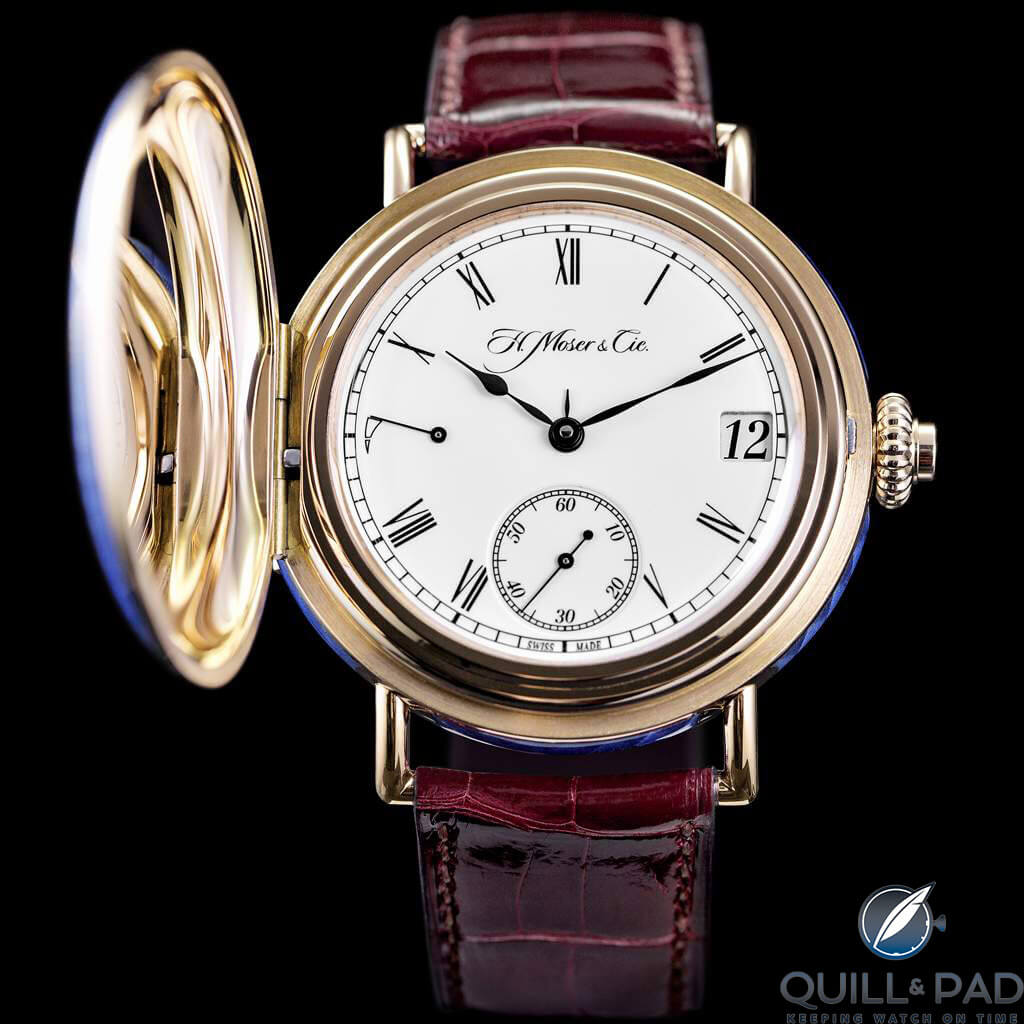
H. Moser & Cie. Perpetual Calendar Heritage Limited Edition with cover open
MG: I love the way Moser offers incredible classical wristwatches, yet tantalizes the senses with watches like its version of the “Apple Watch” and especially this Heritage Limited Edition. The watch doesn’t seem to belong in our time: it’s so delicate and stunningly beautiful, featuring a level of craftsmanship that has become so incredibly rare, yet at the same time is such an important ingredient to explaining why haute horlogerie is such a magical place.
This is a watch that makes you dream on multiple levels!
Further reading: Blue For You: H. Moser & Cie. Perpetual Calendar Heritage Limited Edition.
Quick Facts H. Moser & Cie. Perpetual Calendar Heritage Limited Edition
Case: 46 x 13.6 mm, red gold, engraved, enameled, and diamond-set
Dial: white grand feu enamel, flame-blued hands
Movement: manually wound Caliber HMC 341 with 18-karat red gold bridges and main plate, 7 days’ minimum power reserve
Functions: hours, minutes, small seconds; perpetual flash calendar with oversized date, central month hand, and leap year indicator on movement side, power reserve indicator
Limitation: unique piece, 9 other pieces may be created upon order with slight variations to make them each unique as well
Price: 250,000 Swiss francs excluding tax
Piaget Protocole XXL “Secrets & Lights” Venice Micro-Mosaic
IS: It was only a year ago that I first both learnt of, and learnt to appreciate, micro-mosaics in horology with Romain Gauthier’s Logical One Secret Kakau Höfke, which I thought was unlucky not to win the 2015 Artistic Crafts category (see Christ The Redeemer On A Watch: Logical One Secret Kakau Höfke By Romain Gauthier).
While the cuts and placements of the micro-mosaics on the flat surfaces of the Piaget Protocole XXL “Secrets & Lights” Venice look to be easier to cut and pose than on the curved planes of Gauthier’s Logical One, the incredibly small size of the Piaget mosaic allows for near high-resolution artwork. They are more the size of pixels than tiles!
The fine details that the approximately 5,000 glass tiles provide of this image of the Santa Maria Della Salute basilica overlooking the mouth of the Grand Canal in Venice is simply remarkable.
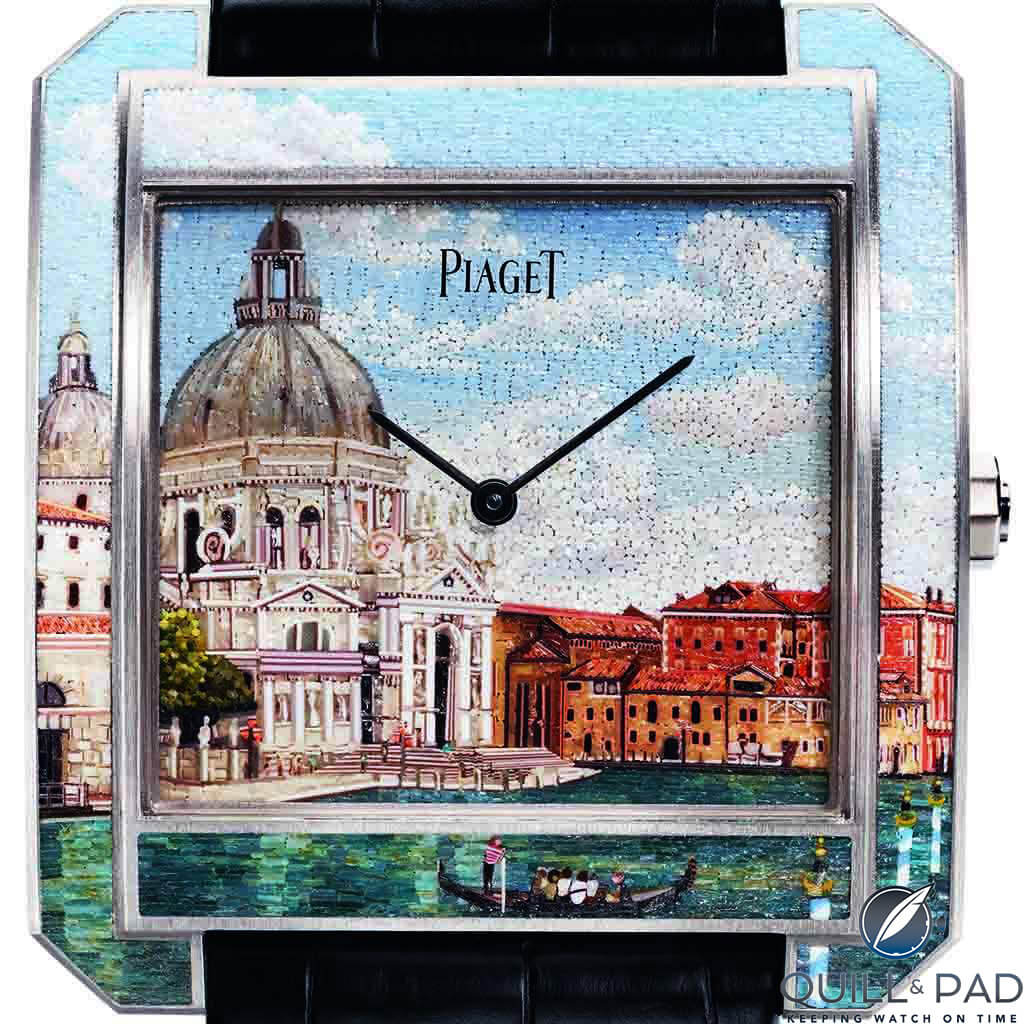
Piaget Protocole XXL “Secrets & Lights” Venice Micro-Mosaic
RS: The dial and bezel of this beauty provide a platform for a mosaic of nearly 5,000 minuscule glass “tesserae” – a marginally higher number than the amount of characters in the name of this watch – to depict the Santa Maria Della Salute basilica of Venice. The composition and the freedom of a canvas that escapes the confines of its crystal, is simply wonderful. This is the most refreshing and optimistic piece of art in the group and makes a micro gallery of your wrist.
GG: The Piaget was my second choice: while it “only” uses a single technique and is quite a large watch at 42 x 46 mm, I found the virtuosity of the micro-mosaic work compelling.
NO: This watch just astounds me. I can’t imagine the number of hours Italian micro-mosaic specialist artist Cesare Bella spent creating it, considering the nearly 5,000 tiny glass tiles that were made and individually placed on the dial and the adjacent “spillway” to create the micro-mosaic Venetian scene.
The colors are perfectly muted – melting flawlessly into one another – giving the motif a vintage quality. The dial is rightfully devoid of anything other than the Piaget logo and the unobtrusive hour and minute hands. This watch gets additional kudos from me for what if represents for Piaget: it is one more demonstration of the brand’s reverence for its métiers d’art and its unwillingness to define any boundaries for itself.
The choice of white gold is a good one since it doesn’t compete with the scheme. And I can’t forget about the patience angle – that’s, I repeat, 5,000 miniscule colored glass pieces – so I’m not surprised there were only three examples produced.
JM: Okay, seriously, the winner for the Artistic Crafts category can only be the Piaget Protocole XXL “Secrets & Lights” Venice Micro-Mosaic.
This Protocole XXL model features a mosaic inlay consisting of more than 5,000 pieces of glass tile. You read that right, five thousand. The word glass tile is deceptive, though, as many of these pieces of colored glass aren’t any larger than a grain of sand. And yet they are expertly and painstakingly arranged to create a miniature scene of the Santa Maria Della Salute basilica and the canal out front.
All of the crafts involved in the Artistic Crafts category are incredible and require extremely skilled artisans, but this watch borders on insanity. The amount of time and effort that go into making any mosaic is already extreme, so one at this scale and with this detail is even more extraordinary.
The style might not be for everyone but the skill and effort involved in placing the thousands of micro sized slivers of glass to create this scene cannot be ignored. I simply must predict this watch to be the winner for the sheer effort and dedication involved.
All of the contenders are undoubtedly masters, but Cesare Bella, the artist behind the Protocole XXL “Secrets & Lights” Venice Micro-Mosaic is beyond fantastic!
MG: Micro-mosaic . . . do I need to say more?
From a distance you might be fooled in thinking that it is grand feu enamel, but take a loupe, examine this Piaget, and be blown away! Although rare, there are other watches featuring mosaic dials, yet none with the refinement of the “Secrets & Lights” Venice.
Depicting one of the most defining scenes in picturesque Venice, the details are breathtaking. And to think that it has been made up of nearly 5,000 minuscule glass tesserae, which not only cover the dial, but also the case of the Protocole XXL.
Further reading: Piaget’s Mythical Journey To Secrets And Lights: A Collection Of Stunning One-Of-A-Kind Timepieces.
Quick Facts Piaget Protocole XXL “Secrets & Lights” Venice Micro-Mosaic
Case: 42 x 46 x 10.3 mm, white gold
Movement: manually wound Caliber 830P
Dial: micro mosaic using 5,000 glass tesserae
Functions: hours, minutes
Limitation: 3 pieces
Price: 249,000 Swiss francs
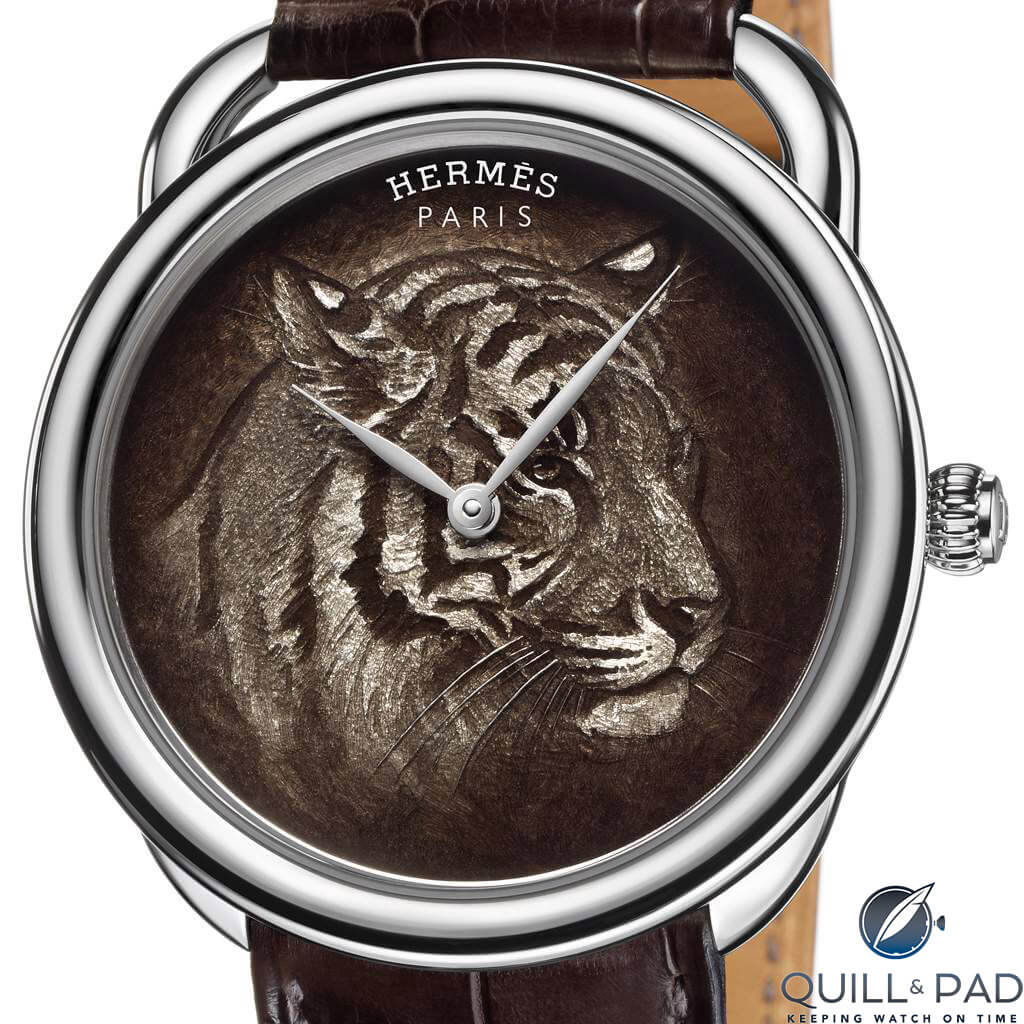
Hermès Arceau Tigre
Hermès Arceau Tigre
NO: I was first acquainted with this watch via pictures, and I was impressed. But when I saw Hermès Arceau Tigre for the first time “in the metal” I was bowled over.
The shaded enamel technique used, email ombrant, results in a motif that reacts with light in a stunning way because of the combined effect of the engraving and varying depths of enamel. The outcome is a nuanced dial like I’ve not seen in before, and given the time and better vision, I could probably count each hair in the tiger’s fur – that’s how detailed the image is.
The earth tones of the dial are further ramped up by the use of white gold to create the seemingly simple Arceau case, framing the tiger like the piece of fine art it is.
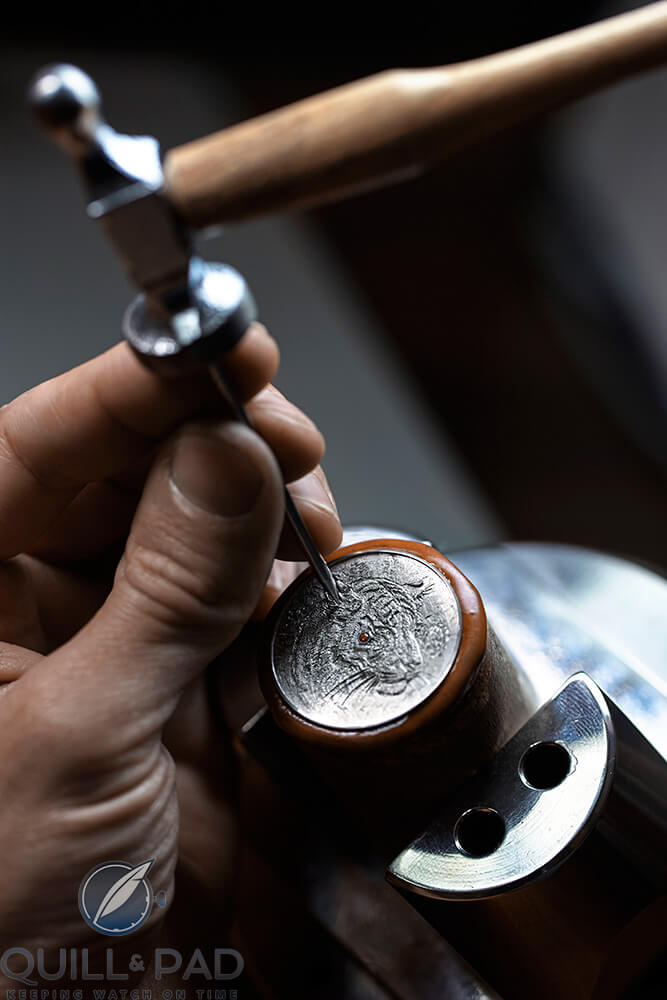
Engraving the dial of the Hermès Arceau Tigre Email Ombrant (photo courtesy Johann Sauty)
IS: What has really impressed me about the Hermès Arceau Tigre isn’t so much the impeccable execution of the email ombrant tiger’s head dial, which has revealed fine details right down to individual hairs, which I also noticed, Nancy − just check out three-dimensionality of the individual cat whiskers − but the fact that the technique itself had never been used (in modern times at least) on such a miniature scale as this.
The fine details of the tiger’s head on the dial are not created by miniature painting or engraving (though it is engraved), but by the shadows (ombrant) created by differing thicknesses of enamel. It is the enamel that brings the subject to life.
Artist Olivier Vaucher spent two years developing the technique with no guarantee of a commercially successful result, and I doff my hat to Hermès for supporting what would otherwise likely have been a lost art to horology.
Elizabeth, Gary, and I were honored to have had the opportunity to interview Vaucher at Baselworld and we were blown away by the sheer dedication and artistry that went into this chef d’œuvre.
If the Hermès Arceau Tigre wins this category, then I for one will consider it very well-deserved recognition indeed.
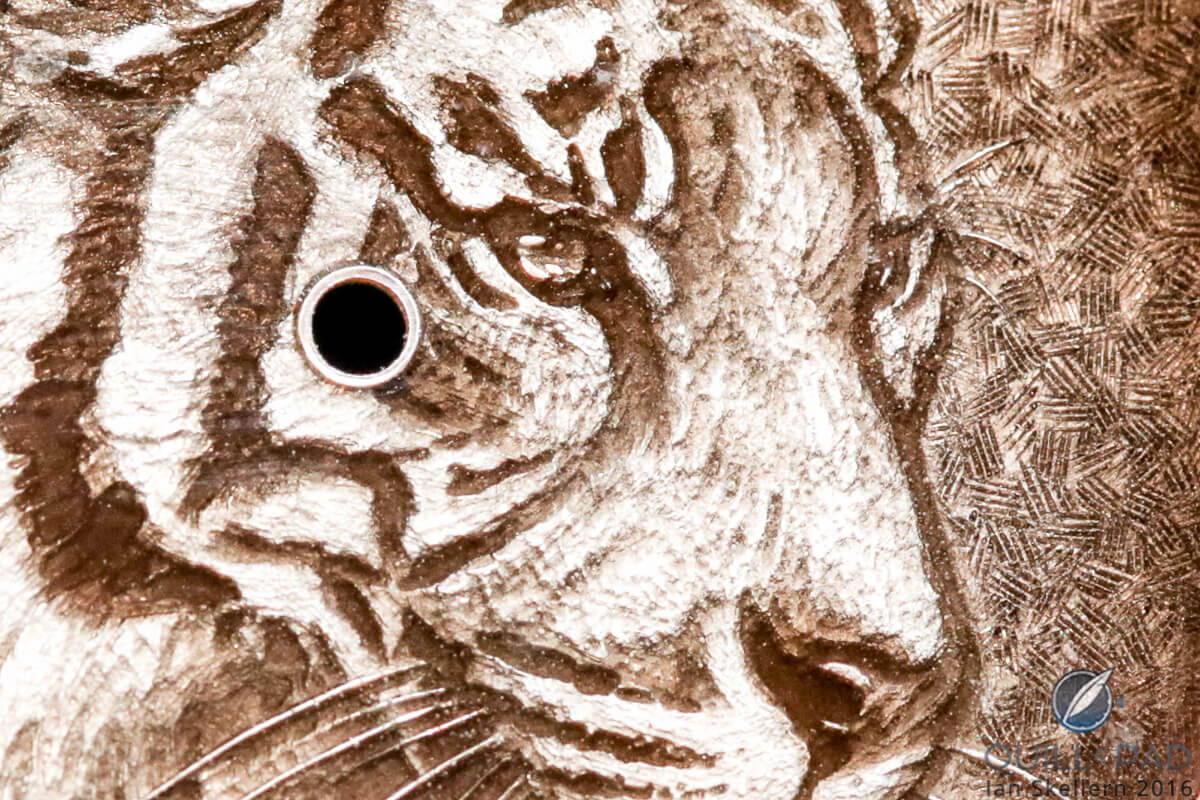
A very close look at the dial of the Hermès Arceau Tigre Email Ombrant
GG: As you just explained, Ian, I also saw this watch at Basel and met the engraver and enameller responsible for creating the email ombrant dial, and I can say that it’s one of those pieces that photographs just can’t portray accurately. The subtlety and depth of the rendering of the tiger are just phenomenal; and the underlying technique is both interesting and required multiple iterations to perfect.
RS: Several of this year’s entrants combine engraving and enamel to create an image of compelling depth, but the one that does so with the greatest standalone competence is the Arceau Tigre.
What at first appears to be a charcoal rendering of a tiger in sorrowful contemplation is actually Vaucher’s email ombrant technique. The tiger is relief-engraved into the dial and coated with translucent enamel of varying thickness to produce a deep three-dimensional image.
It’s utterly beautiful, and that it doesn’t make my top three is testament to the sheer heavyweight technique being piled into the others. I can imagine the wearer of this watch making it several hours into the day before realizing that the correct time had not yet been set, and suffering no shame for it.
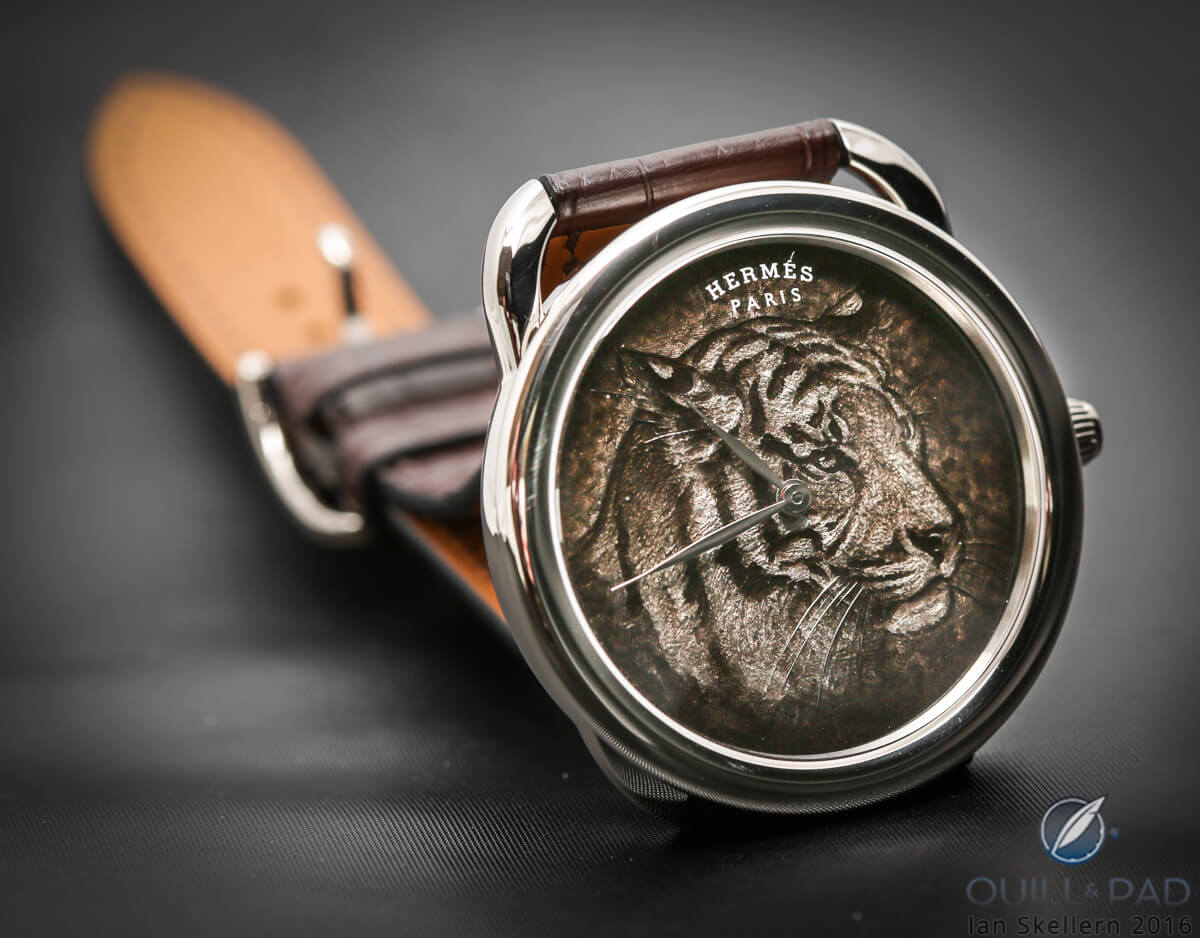
Hermès Arceau Tigre
JM: The category was so hard that my second runner-up finds a tie between two incredible watches. The Hermès Arceau Tigre features an extraordinarily subtle and beautiful hand engraved dial in negative relief that is then coated by semi-transparent tinted enamel.
The variation in the depth of the engraving and the resulting thickness of the enamel creates delicate shadows and a rich texture that mimics the chiaroscuro of the original hand sketch.
Further reading: Roaring Into Life At Full Gallop: Hermès Arceau Tigre Email Ombrant.
Quick Facts Hermès Arceau Tigre
Case: white gold, 41 x 8.24 mm
Movement: automatic Hermès Caliber H1837 with 50-hour power reserve
Dial: white gold with biscuit porcelain and émail ombrant
Functions: hours, minutes
Limitation: 12 pieces
Price: 90,000 Swiss francs
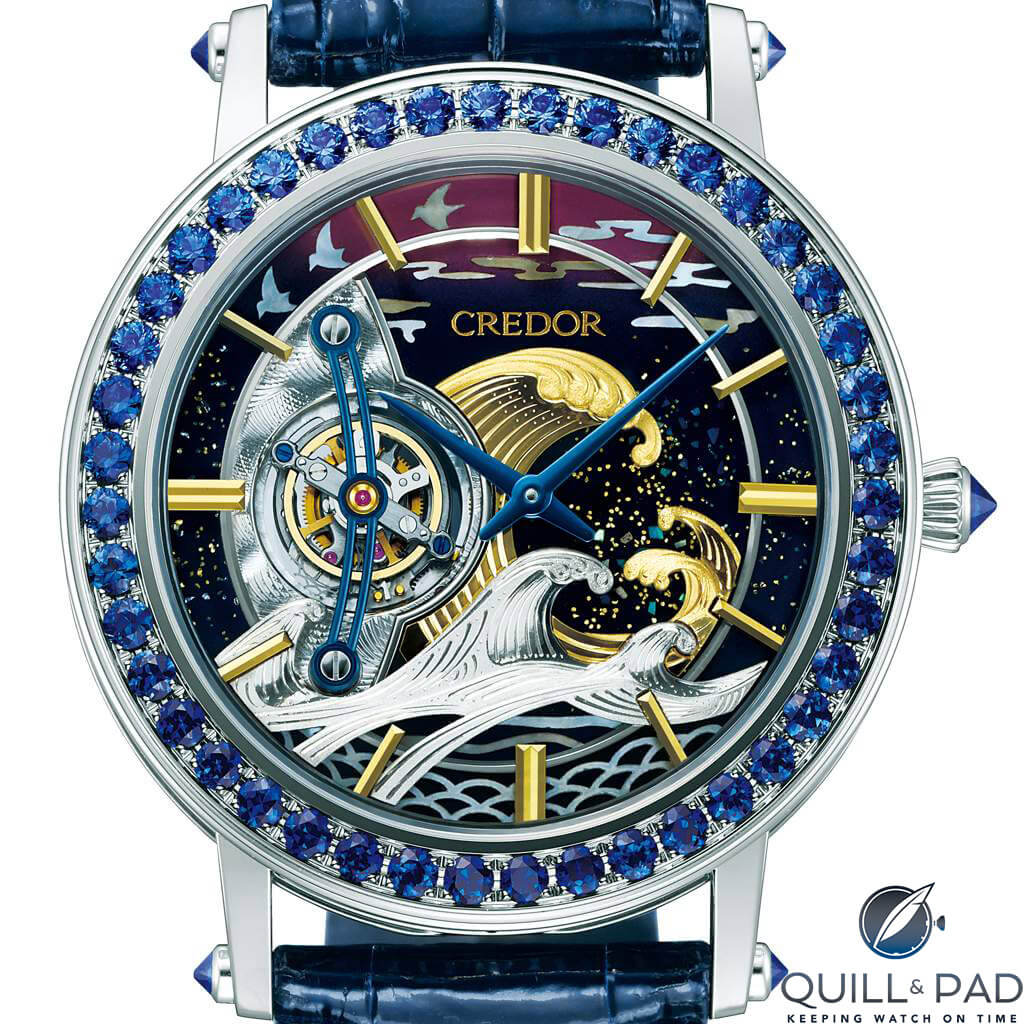
Credor Fugaku Tourbillon
Credor Fugaku Tourbillon
NO: The Seiko Credo Fugaku Tourbillon gets my vote for first place, since it is both forward-thinking in its creation and in the number of artisanal techniques used and extremely traditional in its execution and subject matter. It was one of the most talked-about pieces at Baselworld 2016, and it represents Seiko’s first tourbillon − and an in-house one at that.
The dial is amazingly congruous given the varying volumes and elements, including sculpted white and yellow gold for the waves, mother-of-pearl, authentic Maki-e, and multi-hued lacquer. And the tourbillon imaginatively becomes part of the overall seascape in placement and tone.
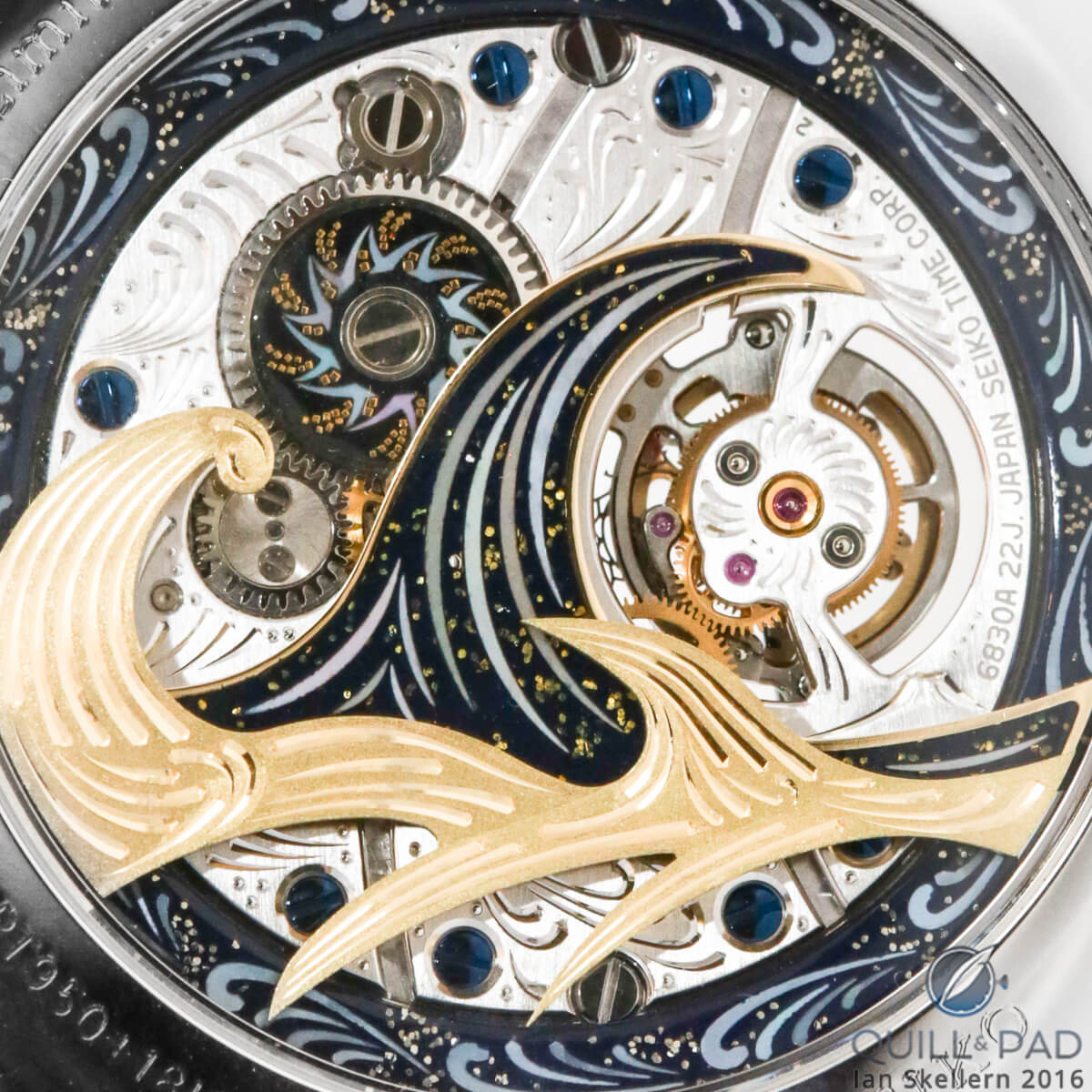
A close look at the incredible details on the highly decorated movement visible through the display back of the Seiko Credor Fugaku Tourbillon
The exhibition case back provides a view of a complementary wave motif, beautifully incorporating Caliber 6830 into the overall design. The amount of forethought and talent that went into the making of this timepiece is evident.
Seiko brought its best to the table, engaging in-house master craftsmen to interpret their respective crafts, while obviously keeping the harmony of the finished piece in mind at all times.
Every time I look at this watch, front or back, I notice a detail I’d not seen before. And if I close my eyes I can almost hear the waves.

A close look at details on the dial of the Seiko Credor Fugaku Tourbillon
IS: The first thing I’d like to note about the Credor Fugaku Tourbillon is that the photos − especially the press photos − do not at all do the piece justice. The artwork has much more three-dimensionality than these two-dimensional images convey: those yellow and white gold waves are over a millimeter thick.
The waves are inspired by nineteenth-century Japanese artist Katsushika Hokusai’s painting “The Great Wave off Kanagawa,” which gained worldwide recognition for its dynamic composition and use of perspective, and that sense of movement has certainly carried through to this miniaturized depiction on both the front and back of this Seiko tourbillon.
I mentioned earlier that displaying the mastery of just one technique is unlikely to impress the jury in this category, and the Credor Fugaku Tourbillon combines no less than three officially recognized Japanese master craftsmen: watchmaker Satoshi Hiraga, designer and engraver Kiyoshi Terui, and Urushi lacquer work by Isshu Tamura. I like the organic touch provided by Urushi lacquer which is from the sap of the Urushi tree.
I love the sense of motion in this piece and the mother-of-peal elements in the dial, and blue sapphires set around the bezel really frame the artwork nicely. This is yet another watch that would not surprise me if chosen as the winner of this category.
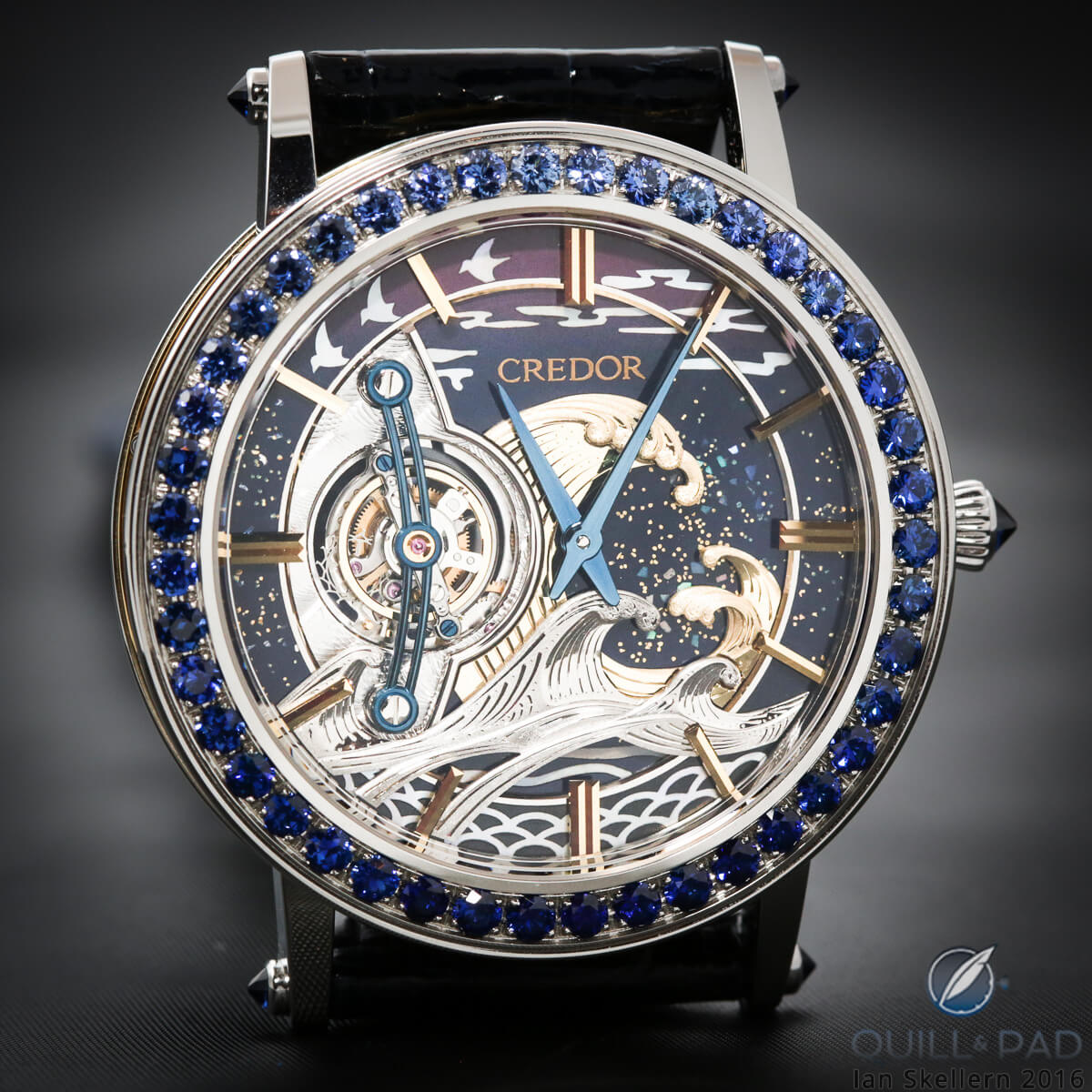
Seiko Credor Fugaku Tourbillon
RS: Although this watch appears to have as many detractors as it does fans, there is no doubt that Seiko has thrown everything from their top drawer at the Fugaku Tourbillon. At once both a tour de force of engraving and lacquer and a celebration of Hokusai’s iconic “Great Wave off Kanagawa,” the skills of three of Seiko’s most experienced craftsmen are on powerful display here.
The back and front of the Fugaku Tourbillon feature explosions of mother of pearl, yellow and white gold, that combine to recreate the foaming tumult of a giant wave in the moonlight. It’s go big or go home in this category − and the Fugaku Tourbillon isn’t leaving anytime soon.
GG: For me the Credor Fugaku Tourbillon was a stunning technical tour de force but ultimately an artistic failure. In my opinion (and it’s only that), the multiple techniques used don’t combine into a coherent whole, and to my eye the interpretation of the legendary Great Wave woodcut was not sufficiently faithful to the spirit of the original.
Further reading: Seiko’s Credor Fugaku Tourbillon: A Masterpiece Of Horological Art.
Quick Facts
Case: 43.1 x 8.8 mm, platinum/white gold with 48 blue sapphires (3.22 ct)
Dial: engraved white and yellow gold with Urushi lacquer, mother-of-pearl, Yakogai (turban shell)
Movement: manually wound Seiko Caliber 6830, 21,600 vph frequency, 37-hour power reserve
Limitation: 8 pieces
Price: $460,000 / 446,500 Swiss francs
Voutilainen Triton et Sirène
IS: As much as I am a fan of Kari Voutilainen, for a small independent he has both appeared and won so regularly in the GPHG over the years − including winning Best Men’s watch 2015 for the same model featured here − that I was very tempted to pay scant heed to his entry this year.
And with reason, I mean who on earth offers a completely unadorned dial in the Artistic Crafts category? That’s just taking the mickey.
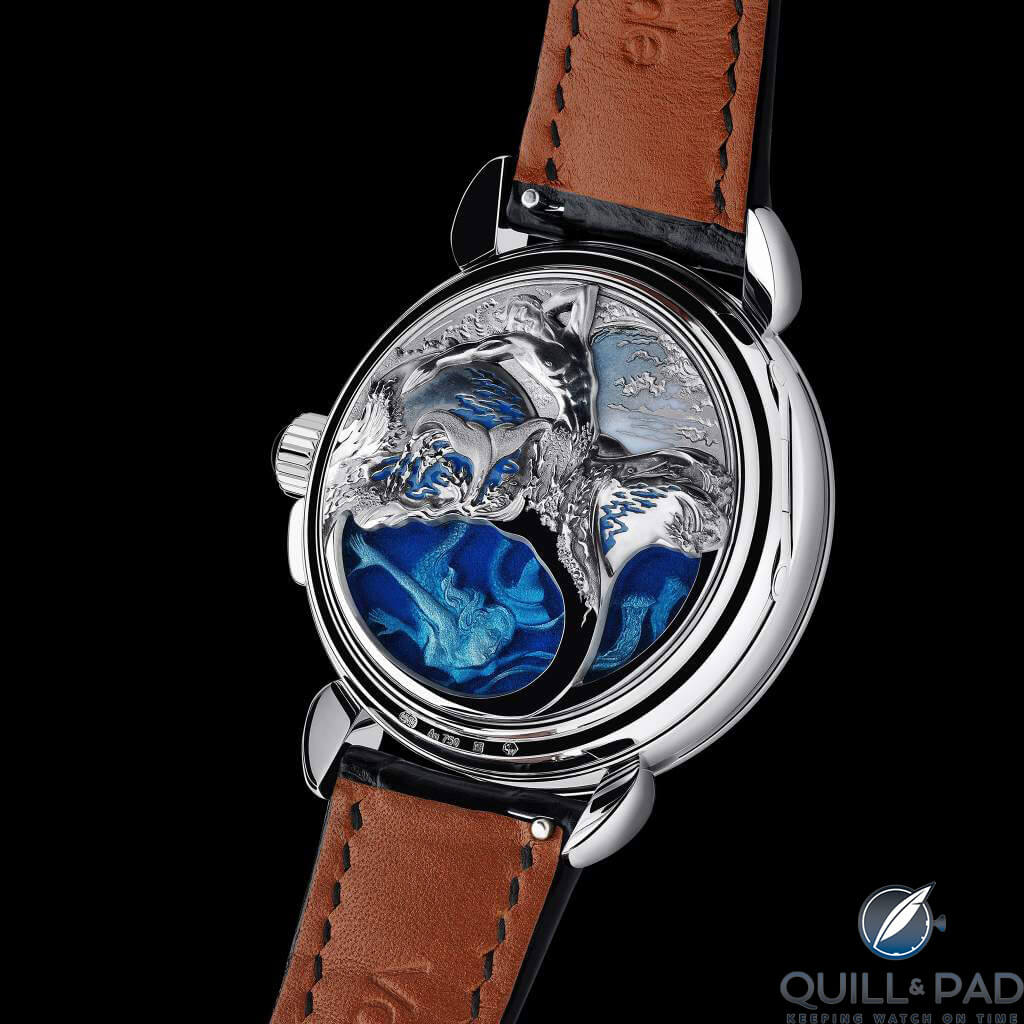
Voutilainen Triton et Sirène with the back cover closed
But − and what a big BUT this is − just turn the Triton et Sirène over and look at the back. The fluidity of the engraving, though sculpture seems a more appropriate word for the three-dimensionality, both real and evoked, is simply sensational. And the ethereal beauty of that seemingly translucent blue looks to be due more to witchcraft than artistic craft.
Master engraver Eddy Jaquet and enameller Inès Hamaguchi have not disclosed how they achieved such an incredible stained-glass type effect, but as much as I’d like to give somebody else a chance, I’m predicting Kari Voutilain will be adding yet another GPHG statue to his cabinet very soon (and perhaps more than one this year).
This piece has captured my heart like no other. I congratulate Jaquet, Hamaguchi, and Voutilainen on pushing the emotional and technical boundaries of artistic craft further than my old jaded heart thought possible.
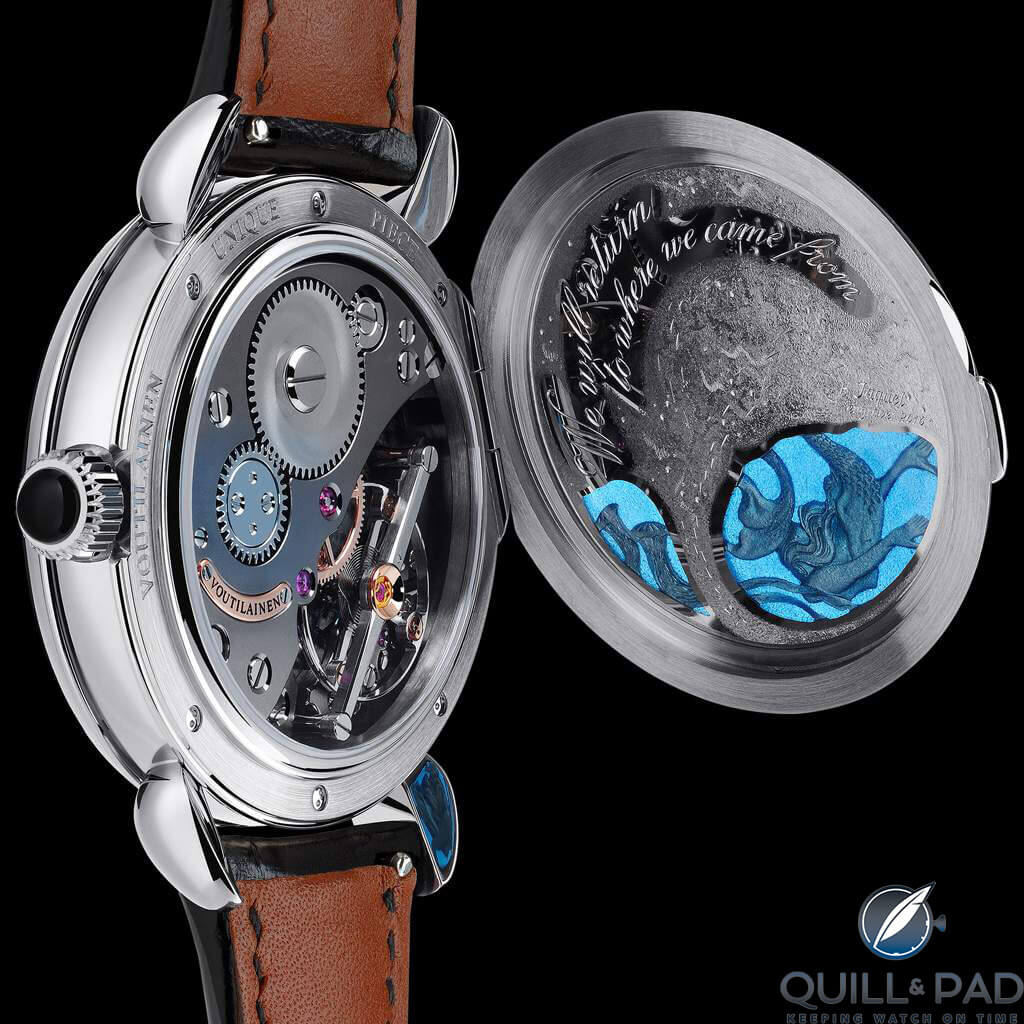
Inside of the back cover of the Voutilainen Triton et Sirène
RS: At first the Triton et Sirène looks surprisingly similar to the deserving winner of 2015’s Men’s prize, as you said, Ian, but this version of the GMR is the closest thing to a “mullet” as it gets in the Voutilainen portfolio: business in the front, party in the back.
It is absent of the more common and exquisite guilloche dial (which one could be forgiven for assuming that Kari’s craftsmen can execute in their sleep), although the traditional Voutilainen hands and applied numerals carry artistic merit and deliver an exceptionally handsome dial.
It is the officer’s case back, however, that will drop your jaw. The combined efforts of Jaquet and Hamaguchi mix fine engraving with champlevé and plique-à-jour enameling to create something of wild and mythical expression, fit for a Greek god and with the allure of a siren.
The engraving and champlevé depict a violent ocean surface, and the plique-à-jour literally traps an engraved mermaid within the deep blue enamel to bring life to the ocean depths. It’s evocative, exotic, complex, and amazing. It would be cheating, but oh so easy, to add further points for the movement itself, but with the Triton already at the top of my list, it makes for a full-pace victory lap of sorts.
GG: As the owner of a Kari Voutilainen watch with custom engraving by Eddy Jaquet (see Commissioning A Watch: My Journey With The Kari Voutilainen Masterpiece Chronograph II), I might be expected to be a fan of the Triton et Sirène. And I am! I particularly appreciated the difficulty of portraying the mermaid to be viewed from both the interior and exterior of the hinged case back and the harmonious melding of the engraving and enameling arts employed.
JM: For my first runner-up, the art of enamel is taken one step further with something I have never before seen on a wristwatch. Actually, I can’t say that I have personally seen an example of this technique anywhere.
The Voutilainen Triton et Sirène is one-half awesomazing Kari Voutilainen watchmaking and one-half increditastic engraving and enamel work. The watch features a rear case that has multiple layers of deep relief engraving, overlaid in spots with subtle yet beautiful enamel.
But the real focus is the completely see-through section of the case with an engraving suspended in translucent enamel. An enamel technique called plique-à-jour was used to suspend the mermaid engraving in enamel and make it viewable from both the inside and outside of the case.
This feature surprised me when I saw it, and I am still in awe of its complexity and creativeness. This piece definitely deserves to be raved about.
Quick Facts Voutilainen Triton et Sirène
Case: white gold, 39 x 13.8 mm with officer’s case back
Movement: manually wound Voutilainen Caliber Vingt-8 GMR
Functions: hours, minutes, seconds; power reserve indication
Limitation: one unique piece
Price: 180,000 Swiss francs
Predicted Winners
Ian: Kari Voutilainen Triton et Sirène
Ryan: Kari Voutilainen Triton et Sirène
GaryG: Hermès Arceau Tigre
Nancy: Credor Fugaku Tourbillon
Joshua: Piaget Protocole XXL “Secrets & Lights” Venice Micro-Mosaic
Martin: Piaget Protocole XXL “Secrets & Lights” Venice Micro-Mosaic
And the winner of best Artisic Crafts watch at the 2016 GPHG went to the Piaget Protocole XXL “Secrets & Lights” Venice Micro-Mosaic.
For more of our predictions in the 2016 Grand Prix d’Horlogerie de Genève (GPHG), please see:
Tourbillon Category
Ladies’ High-Mech Category
Jewellery Category
Calendar Category
Travel Time Category
Mechanical Exception Category
Petite Aiguille
Aiguille d’Or
Trackbacks & Pingbacks
-
[…] don’t always pick a Voutilainen watch as number one in this category (last year’s Triton et Sirène – see our predictions for the 2016 Artistic Crafts – was my number three pick), but this one is just too […]
-
[…] please see: Men’s Category Tourbillon Category Ladies Category Ladies’ High-Mech Category Artistic Crafts Category Chronograph Category Jewellery Category Sport Category Calendar Category Mechanical Exception […]
-
[…] Prix d’Horlogerie de Genève (GPHG), please see: Tourbillon Category Ladies’ High-Mech Category Artistic Crafts Category Jewellery […]
-
[…] Prix d’Horlogerie de Genève (GPHG), please see: Ladies Category Ladies’ High-Mech Category Artistic Crafts Category Jewellery Category Calendar Category Travel Time Category Mechanical Exception Category Petite […]
-
[…] Category Ladies’ High-Mech Category Artistic Crafts Category Sport Category Calendar Category Travel Time Category Mechanical Exception Category Petite […]
-
[…] For more of our predictions in the 2016 Grand Prix d’Horlogerie de Genève (GPHG), please see: Tourbillon Category Jewellery Category […]
-
[…] Grand Prix d’Horlogerie de Genève (GPHG), please see: Men Tourbillons Ladies Ladies’ High-Mech Artistic Crafts Chronographs Jewellery Sports Travel Time Mechanical Exception Petite Aiguille Aiguille […]
-
[…] Grand Prix d’Horlogerie de Genève (GPHG), please see: Men Tourbillons Ladies Ladies’ High-Mech Artistic Crafts Chronographs Jewellery Sports Calendar Travel Time Petite Aiguille Aiguille […]
-
[…] Category Predictions For The Ladies Category Predictions In The Ladies’ High-Mech Category Predictions In The Artistic Crafts Category Predictions In The Chronograph Category Predictions In The Jewellery Category Predictions […]
-
[…] for GMR 2016 Two watches are currently pre-selected: Scintillante in the Jewellery category and Triton et Sirène in Artistic Crafts. Winners to be announced on November […]
-
[…] Category Predictions For The Ladies Category Predictions In The Ladies’ High-Mech Category Predictions In The Artistic Crafts Category Predictions In The Chronograph […]
Leave a Reply
Want to join the discussion?Feel free to contribute!

While I definitely appreciate and respect the artistic talent it takes to produce these intricately crafted pieces, they are not my cup of tea. That being said, I’d gladly wear that Voutilanien and the Moser also (sans the two case covers, of course!). I think the Credor Tourbillon takes the prize.